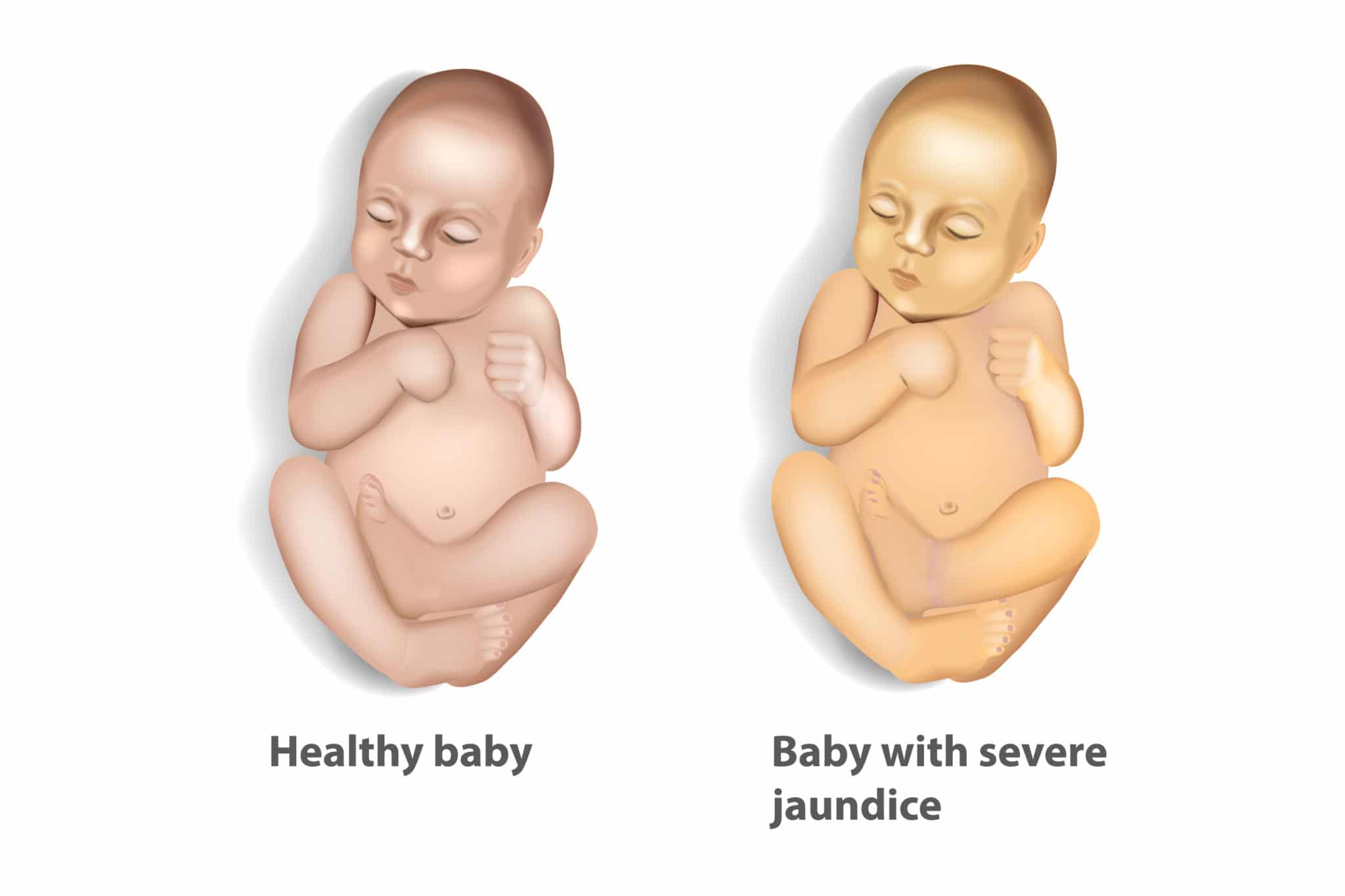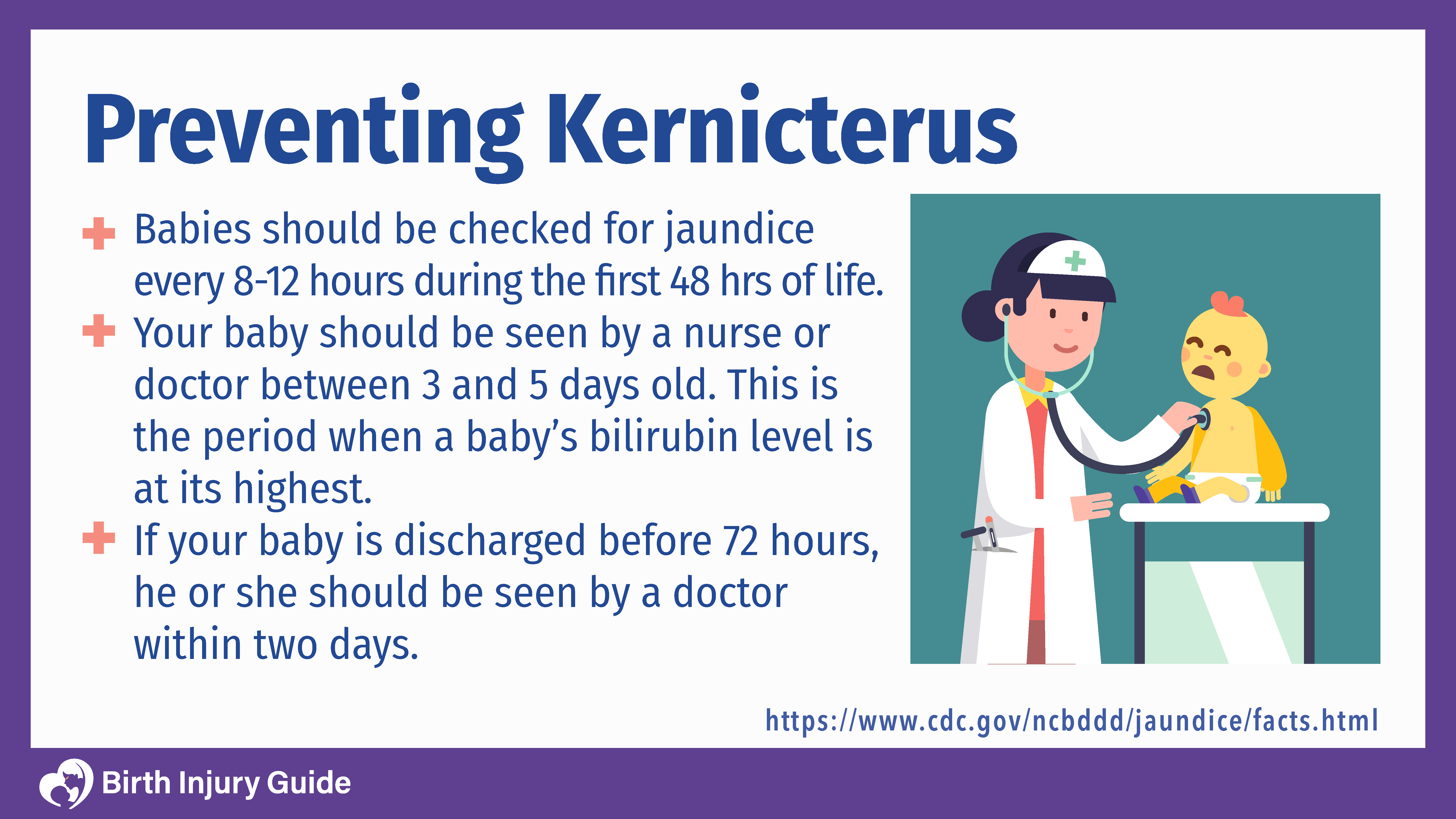
Kernicterus
You may be familiar with the medical condition called jaundice. Jaundice is a common medical condition affecting newborn babies. In fact, the Centers for Disease Control and Prevention (CDC) estimates as many as 60% of newborns have jaundice. While most people know what jaundice is, there is a common misconception that jaundice is harmless and that babies who develop it won’t face any additional problems. The fact is, however, that if jaundice is unmonitored, it can lead to serious medical complications, such as kernicterus, a rare type of brain damage. Kernicterus may also be called acute bilirubin encephalopathy.
Kernicterus is a rare but dangerous form of brain damage that occurs when jaundice is untreated or escalates. It is more common in premature infants than in full-term infants. It affects both sexes equally. It may be more common in babies of a Mediterranean or East Asian descent, and may be harder to detect in babies with darker skin tones.
It is important to understand the risks surrounding jaundice, including Kernicterus, and what treatment options are available for your infant.
What is Jaundice?
Jaundice is a medical condition that occurs when bilirubin builds up in the bloodstream. Bilirubin is a pigment found in red blood cells. It has an orange-yellow colored bile product. The pigment sheds and passes through the liver as the hemoglobin in red blood cells break down (hemolysis). With jaundice, however, the liver does not properly break down bilirubin, leading to high levels of bilirubin in the blood. Because it is a pigment, infants look yellowish. The yellow color generally starts on the face and moves to the chest and then further out.
During pregnancy, bilirubin crosses the placenta into the mother’s bloodstream, where it is broken down and filtered out through her liver. However, if there are placental problems that impede this process, the baby’s bilirubin levels may be abnormally high after birth. Also, premature babies may not have the adequate liver function necessary to filter out bilirubin levels, which can lead to jaundice or kernicterus (bilirubin encephalopathy).
Other symptoms may include:
- Lethargy (excessive sleepiness)
- Difficulty waking
- Not feeding well from a bottle or breast
- Excessive fussiness
- Decrease in wet or dirty diapers
These are common symptoms of mildly elevated bilirubin levels, and are generally nothing to be too concerned about. However, if your baby has any of the following symptoms, you should get emergency medical help right away:
- High pitched crying
- Arched back while crying
- Body is limp or floppy
- Strange eye movements
If your baby is still in the hospital, they are likely being routinely checked for jaundice via blood test. Doctors can also test your baby’s blood to see how high bilirubin levels are. Bilirubin levels generally peak around 3-5 days old. If your baby is still at the hospital, doctors and nurses will pay close attention to their skin and bilirubin levels during this time. If you are at home, it is important to recognize possible signs of jaundice and talk to your doctor as soon as possible.
Jaundice on its own can be treated relatively easily. Doctors use special lights to help remove excess bilirubin from the body. Baby’s are mostly undressed and placed under these special lights or a lighted blanket for a certain amount of time. If that doesn’t clear it up, the doctor may do a blood exchange transfusion.

Newborn jaundice generally resolves within 1 to 2 weeks. However, 1 in 20 newborns will have severe jaundice, which may require hospitalization.
What is Kernicterus?
Kernicterus, also known as Hyperbilirubinemia or bilirubin encephalopathy, is a rare neurological disorder that occurs when hyperbilirubinemia damages the brain. Whereas with jaundice treatment reduces bilirubin levels and the baby recovers, kernicterus means that bilirubin levels are toxic. Excess levels of bilirubin in the baby’s blood can enter brain tissue and cause damage. This occurs in around 5% of babies who have jaundice – or around one in every 44,000 newborns. Generally, jaundice is treated before bilirubin levels get too high and there is a risk of brain damage. Unfortunately, not all babies are diagnosed and treated quick enough to prevent kernicterus.
Brain damage caused by kernicterus often affects parts of the brain responsible for hearing, movement and other motor functions. Primarily, this includes the brainstem and the basal ganglia. Kernicterus is linked to hearing loss, vision problems, athetoid cerebral palsy and intellectual disabilities. In the most severe cases, kernicterus can be fatal.
How is Kernicterus a Birth Injury?
Some people think that birth injuries are mistakes made at the child’s birth that affects the baby for a lifetime – or at least for a few years. While this is sometimes true, Kernicterus may qualify as a birth injury if a physician fails to detect and monitor the high levels of bilirubin or recognize the signs of bilirubin encephalopathy. While no parent or doctor could have caused Kernicterus in the baby, it is the doctor’s responsibility to recognize risk factors and diagnose and treat the condition before it escalates. Mistreatment of this condition could result in brain damage that will change the infant’s life forever.
Failure to diagnose and treat a medical condition appropriately is one of the more common reasons why people file medical malpractice or birth injury lawsuits. Patients have the right to adequate care that meets accepted medical standards. When doctors do not provide adequate care and the patient is harmed, the patient or loved ones should explore their legal rights. Medical negligence is never “okay”. Healthcare providers should be held accountable.
Start Your FREE Case Review Today
If you or your child is injured as a result of medical negligence, call us to learn more.
Symptoms of Kernicterus
Kernicterus symptoms will greatly depend upon if it’s in an early or later stage of the disorder. Generally, symptoms begin two to five days after the baby is born. The most notable symptom is, of course, the yellowing of the baby’s skin, whites of the eyes and mucous membranes. Other symptoms may develop, however, as the condition progresses.
Symptoms associated with the early stage include:
- Poor feeding and sucking
- Excessive jaundice
- Hypotonia
- Fatigue and lethargy
As the condition progresses, symptoms may include:
- High-pitched shrieks and cry
- Seizures
- Bulging on the infant’s “soft spot” (fontanel)
As Kernicterus reaches the most severe stage, symptoms may include:
- Hearing loss (high-frequency)
- Vision loss
- An increase in seizures
- Muscle stiffness and problems with movement
How Does Kernicterus Affect Children?
It’s extremely important that healthcare providers monitor jaundice, especially within the first 24 hours of the condition developing. Along with the aforementioned symptoms, Kernicterus can lead to a number of neurological disorders, some slight such as minor learning disabilities, and some as serious as athetoid cerebral palsy. Other risks and complications include complete hearing loss, and even death.
Diagnosing Kernicterus
To diagnose kernicterus, your doctor will carefully assess your baby and their symptoms. General guidelines for postnatal care include monitoring and checking the baby’s bilirubin level via a blood test. Babies with higher than 25 milligrams of total serum bilirubin in their blood will be treated, often in the hospital, until bilirubin levels decrease. Kernicterus can occur in babies with a bilirubin level below 25 mg, so it is important that doctors carefully examine and monitor the baby. Bilirubin levels alone are generally not enough to make a complete diagnosis. Your doctor must consider blood tests, symptoms and the child’s overall health. Immediate diagnosis and treatment can prevent brain damage from occurring.
Can Kernicterus be Prevented?

Since 60-80% of newborns have some level of jaundice, the best way to prevent kernicterus is to recognize the risk and take measures to diagnose and treat jaundice quickly. Although in many cases, there is no known way to discern which infant will develop jaundice severe enough to cause Kernicterus, there are some risk factors that increase the risk of a baby developing kernicterus. These include:
Blood Type Differences
Babies with Rh hemolytic disease are at a heightened risk. Rh hemolytic disease causes fetal blood cells to cross the placenta and enter the mother’s bloodstream. The mother’s body forms antibodies against the foreign invaders, which causes destruction of fetal blood cells when the blood crosses back into the placenta. In response to the destruction of red blood cells, the fetus’ bone marrow will release immature red blood cells. The hemoglobin from the destroyed cells breaks down into bilirubin. Generally, bilirubin is broken down by the mother during pregnancy. Rh hemolytic disease can compromise this process leading to abnormally high levels of bilirubin at birth.
Premature Birth
A baby’s liver is fully developed around 37 weeks gestation. The liver of a premature baby may not be developed enough to properly remove excess bilirubin from the blood. That makes them more susceptible to jaundice and kernicterus.
Poor Feeding
Babies that do not eat enough and do not properly eliminate waste are more likely to develop jaundice. This puts them at a higher risk of developing kernicterus as well.
Bruising During Birth
Bruising increases red blood development and breakdown. A baby with a lot of bruising during birth may have higher bilirubin levels due to the bruising. This makes them more vulnerable to jaundice or kernicterus, especially if they are premature or have other risk factors.
Genetics
Genetics can play a role in the risk for kernicterus. Babies with a family history of jaundice may be predisposed to have similar disorders that affect the breakdown of red blood cells. Another genetic factor is ethnicity. Babies who are Mediterranean or East Asian are more likely to have jaundice.
Dark Skin
Babies with a darker skin color are more likely to develop kernicterus because jaundice is more difficult to identify. That means that jaundice may go undiagnosed and untreated, which is a leading reason why the condition progresses into kernicterus.
Treatment
Treatment for kernicterus depends on the age of the baby (in hours) and what the level of bilirubin actually is. phototherapy might be something you want to discuss with your doctor if the baby has high levels of bilirubin, but if the baby has had high levels of bilirubin for a while, your doctor is likely to start the process of plasma transfusions, getting more normal-celled blood into the baby’s system as soon as possible. More details about possible treatment options are as follows:
Light Therapy
Light therapy, or phototherapy, is the most common treatment for jaundice, and is also used for kernicterus. During light therapy, your baby is placed under special lights, or on a lighted blanket. The light interacts with the bilirubin and changes its shape. That makes it easier for the liver to remove it. If your baby has kernicterus, doctors may use several lights to speed up elimination. During light therapy, your baby may be fed through a feeding tube or an IV. You can expect bilirubin levels to be checked every 4-6 hours until the levels begin to fall. Light therapy generally resolves excess bilirubin in 1-2 days.
Plasma Transfusion
If light therapy does not work, or the babies bilirubin levels are too high, your doctor may recommend a plasma transfusion. This process involves gradually replacing your baby’s blood with donor blood that does not have excess bilirubin present. Your baby’s bilirubin levels will be checked two hours after the transfusion. In some cases, more than one is necessary to get bilirubin levels where they should be.
Prognosis for Infants with Kernicterus
Kernicterus is a serious medical condition that can be life-threatening. The overall prognosis for an infant with kernicterus will depend on the severity of their condition and how quickly medical treatment began. With timely diagnosis and treatment, babies with this condition can recover with few, if any, long-term complications. However, even mild kernicterus can cause brain damage that results in neurological effects and motor skill disorders.
More severe cases of kernicterus can cause permanent brain damage, hearing or vision loss, cerebral palsy or even death. The best way to improve the prognosis for babies is to prevent kernicterus from occurring in the first place. When it does occur, doctors must act quickly to treat the condition and prevent additional damage.
Financial Compensation for Kernicterus
If kernicterus is not treated immediately, your baby could have permanent brain damage or conditions like cerebral palsy. These conditions can have a profound impact on your child’s life, and your entire family. Disorders like cerebral palsy require ongoing, often life-long care, supervision and medical treatment. This can costs hundreds of thousands of dollars.
If your child’s condition is the result of medical negligence, however, you may be able to pursue compensation through a birth injury claim. A birth injury claim is a lawsuit filed against the healthcare provider, facility, etc. who you believe is responsible for your child’s injuries.
Successful birth injury claims can result in compensation for families, including:
Medical Expenses
In a birth injury claim, you can pursue damages (compensation) for medical expenses including current medical bills, future anticipated medical costs, costs of therapy, medications, and more.
Lost Income
If a parent has to leave work to attend to the child, you may also be able to pursue compensation for lost wages. This is especially important if one parent has to stay home due to the child having a serious medical condition like cerebral palsy.
Pain and Suffering
If your child has a birth injury, you can also pursue compensation for their pain and suffering. There’s no question that a birth injury impacts the baby now and in the future. In many cases, the baby will struggle with their injuries and disabilities for the rest of their lives.
Home Modifications
If your child has an injury that requires specialized equipment, wheelchairs, etc. you may be able to pursue damages to help you modify your home and make it safe for your child. This is important if your child is in a wheelchair or walker, has limited mobility, or requires specialized equipment for daily activities.
The best way to find out if you qualify for compensation is to contact a birth injury lawyer. At Birth Injury Guide, we can help you find the best lawyer for your child’s case. Our team will help you explore your rights and determine if you are eligible for compensation. Next, we will ensure that you have the tools necessary to build a strong claim and get the justice that your family deserves.
Don’t waste time – Call us today for a free case review!
Start Your FREE Case Review Today
If you or your child is injured as a result of medical negligence, call us to learn more.

